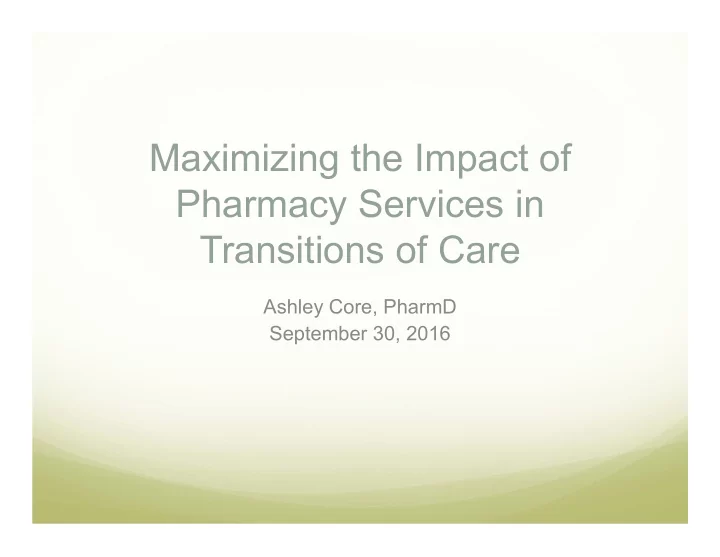

Maximizing the Impact of Pharmacy Services in Transitions of Care Ashley Core, PharmD September 30, 2016
Disclosure Statement The following individuals have nothing to disclose concerning possible financial or personal relationships with commercial entities (or their competitors) that may be referenced in this presentation: Presenter: Ashley Core, PharmD
Objectives Name common barriers encountered in establishing medication reconciliation services Describe the potential impact of pharmacy involvement in medication reconciliation and transitions of care (Pharmacist and Technician) Identify resources that are available to launch or optimize pharmacy services within the transitions of care process
Current State Transitions of care 1 “…the movement of patients between health care locations, providers, or different levels of care within the same location as their conditions and care needs change.”
Recognizing the Need National Patient Safety Goal 03.06.01 2 “…document and pass along information about patients’ medications; review safe practices for medication reconciliation” Centers for Medicare and Medicaid Services 3 “…performs medication reconciliation for more than 50% of transitions of care” Institute for Healthcare Improvement 4 “…prevent adverse drug events (ADEs) by implementing medication reconciliation”
Role of the Health-System Pharmacist? Medication history Bedside pharmacy Admission services medication reconciliation Medication access Disease specific counseling Discharge medication High risk reconciliation medication counseling Discharge counseling Medication therapy Post discharge management phone calls
Potential Impact Improved patient safety Fewer admission medication history-related errors Greater accuracy of discharge summary medication lists Enhanced patient experience Better understanding of discharge medications Cost avoidance Decreased costs/length of stay related to medication errors Reduced emergency department visits Reduced hospital admissions/re-admissions
Supporting Evidence Primary Author Year Intervention(s) Results outcome Gleason et 2010 Medication • Pharmacist-obtained • 35.9% with order error on admission al 5 order errors on medication histories • 85% of errors originated in medication (MATCH) admission • Admission medication histories reconciliation • 52.4% with potential to cause harm without intervention Anderegg 2014 30 day • Admission and discharge • 5.5% decrease in 30 day readmissions et al 6 readmission medication reconciliation in high-risk patients (p=0.042) rate • Expanded clinical pharmacy • Projected cost savings = $780,000 services, including ED Kirkham et 2014 30 day • Bedside medication • Control group had twice the odds of al 7 readmission delivery readmission within 30 days (OR, 1.9; rate • Follow-up phone calls 95% CI 1.92-19) • Six-fold increase in 30 day readmission in patients 65 years or older (OR, 6.05;95% CI, 1.92-19) Sanchez et 2015 30 day • Pharmacist telephone • Decreased 30 day readmission rate in al 8 readmission intervention patients who received pharmacist or ED visit rate intervention post discharge (0.277 vs. 0.519, p<0.001)
Where to begin?!
ASHP-APhA Best Practices 9 “Partnered to assess examples of currently implemented care models that improve patient outcomes by involving pharmacists in medication-related transitions of care…” Reviewed “Medication Management in Care Transitions” models from over 80 institutions Assessment focused on 3 main criteria: Impact of care transitions model on patient care Pharmacy involvement in the transition process from inpatient to home settings Potential to scale and operationalize the process for implementation by other health systems Eight programs distinguished as “Best Practices”
Common Barriers Organization Qualifications Administration Training Medical and nursing staff Coverage hours Staff EHR capabilities Computers Method for information transfer Office Space
Key Characteristics Started out small Pilot programs Launched strategic services Medication reconciliation = key component Considered the needs of the institution Targeted specific patient population(s) Worked within their means Restructured current staff Utilized pharmacist-extenders Grant funding
Key Characteristics Regularly collected and reported data Focused on cost-saving initiatives Medication safety Patient satisfaction scores Looked for opportunities to collaborate Multi-disciplinary care teams Schools of pharmacy and medicine Innovated to expand services Expanded roles for technicians, residents, interns Pharmacotherapy clinic Bedside prescription delivery
Used with permission from ASHP and APhA: Appendix A. Pg 56. Key attributes of programs demonstrating best practices in medication management in care transitions; ASHP-APhA Medication Management in Care Transitions Best Practices; https://www.pharmacist.com/medication-management-care-transitions-best-practices; published February 2013; accessed July 2016.
Used with permission from ASHP and APhA: Appendix A. Pg 56. Key attributes of programs demonstrating best practices in medication management in care transitions; ASHP-APhA Medication Management in Care Transitions Best Practices; https://www.pharmacist.com/medication-management-care-transitions-best-practices; published February 2013; accessed July 2016.
Site Specific Considerations Needs of the organization Current process in place Available staff to be allocated Process for educating staff Patient population to be targeted EHR capabilities Metrics
Creating a Plan for Success Use Identify the Recognize Collect data available need(s) of and devise a to show resources to the patients, plan to impact to launch institution, overcome fund future strategic C-suite barriers service(s) service(s)
Available Resources ASHP-APhA Medication Management in Care Transitions Best Practices 9 MARQUIS Implementation Manual: A Guide for Medication Reconciliation Quality Improvement 10 Transitions of Care Coalition: Care Transition Bundle, Seven Essential Intervention Categories 11 Re-engineered Discharge (RED) Toolkit 12 Medications at Transitions and Clinical Handoffs (MATCH) Toolkit for Medication Reconciliation 13
References 1. Transitions of Care Measures, Paper by the NTOCC Measures Work Group; National Transitions of Care Coalition; http://www.ntocc.org/Portals/0/PDF/Resources/TransitionsOfCare_Measures.pdf; published 2008; accessed August 2016. 2. 2016 Hospital National Patient Safety Goals; Joint Commission; https://www.jointcommission.org/assets/1/6/2016_NPSG_HAP_ ER.pdf ; published 2016; accessed July 2016. 3. Eligible Professional Meaningful Use Menu Set Measures, Measure 6 of 9; Centers for Medicare and Medicaid Services; https://www.cms.gov/Regulations-and-Guidance/Legislation/EHRIncentivePrograms/downloads/7 _Medication_ Reconciliation.pdf; updated 2014; accessed July 2016. 4. Protecting 5 Million Lives from Harm, Overview; Institute for Healthcare Improvement; http://www.ihi.org/Engage/Initiatives/Completed/5MillionLivesCampaign/Pages/default.aspx; accessed August 2016. 5. Gleason KM, McDaniel MR, Feinglass J, et al. Results of the medications at transitions and clinical handoffs (MATCH) study: an analysis of medication reconciliation errors and risk factors at hospital admission. J Gen Intern Med . 2010; 25(5):441-7. 6. Anderegg SV, Wilkinson ST, Couldry RJ, Grauer DW, Howser E. Effects of a hospitalwide pharmacy practice model change on readmission and return to emergency department rates. Am J Health-Syst Pharm . 2014;71:1469-79. 7. Kirkham HS, Clark BL, Paynter J, Lewis GH, Duncan I. The effect of a collaborative pharmacist-hospital care transition program on the likelihood of 30-day readmission. Am J Health-Syst Pharm. 2014; 71:739-45.
Recommend
More recommend